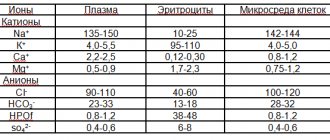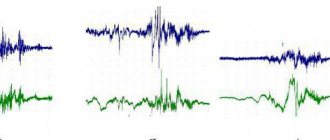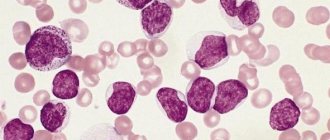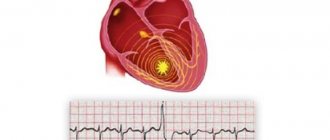Normal indicators
In men and non-pregnant women, the amount of fibrin breakdown products should not exceed 500 ng/ml.
The D-dimer level during pregnancy
varies significantly depending on the period:
- First trimester
. The amount increases one and a half times compared to the amount before conception (on average should not exceed 750 ng/ml); - Second trimester
. The indicators double (do not exceed 1000 ng/ml); - Third trimester
. The amount increases threefold (no more than 1500 ng/ml).
Norms of D Dimer during pregnancy: increased levels of the indicator
An excessive amount of this indicator relative to the norm D Dimer during pregnancy may indicate that the formation of blood clots is increased relative to the norm.
Massive formation of blood clots is characteristic of the following diseases and pathologies of the hemostatic system:
- thromboembolism;
- DIC syndrome;
- hereditary thrombophilia.
In addition, this indicator may increase in the presence of infectious and oncological diseases, as well as any inflammatory processes in the body.
Detection of elevated D Dimer levels during pregnancy can also be caused by the following unusual and pathological situations:
- the presence of multiple pregnancies - carrying twins, triplets, etc.;
- placental abruption before the planned date;
- pathologies of fetal development;
- the presence of internal and external damage and their healing;
- infectious lesions - in particular, of a parasitic nature;
- rheumatoid disease;
- pre-stroke condition or stroke;
- severe toxicosis of pregnant women;
- diabetes mellitus, including at an early stage;
- vein thrombosis;
- dysfunction of the liver or kidneys, as well as the cardiovascular system;
- recent surgery, including on small areas of the body.
If during pregnancy, after a series of tests, a sharp jump towards an increase in the level of D Dimer is detected, this phenomenon may indicate increased formation of blood clots (due to venous thromboembolism or disseminated intravascular coagulation syndrome). Preeclampsia and gestosis can also develop in a similar way. These phenomena can pose a real threat to pregnancy. In this case, treatment with anticoagulant therapy (using injections and droppers) will be required in a hospital hospital.
High D-dimer
Physiologically, D-dimer is elevated during pregnancy, but the increase in its level should not exceed the permissible standards given above.
A high D-dimer is a dangerous condition and means that the pregnant woman has obvious problems with the blood clotting system.
Reasons for the increase in pregnant women:
- Diabetes;
- Kidney diseases;
- Late gestosis;
- Infectious diseases;
- Liver diseases;
- Premature placental abruption
.
Survey
The scope of the examination is determined individually for each patient. In some cases, regular monitoring of coagulogram parameters and D-dimers is sufficient. In severe cases, the examination is carried out jointly with a hematologist.
Consequences
important Elevated D-dimer during pregnancy can lead to serious complications: premature abruption of a normally located placenta, spontaneous miscarriages and premature birth, so the woman should be under constant supervision of medical personnel.
Treatment
A high D-dimer is a dangerous condition, so a pregnant woman must be hospitalized in a hospital for a course of therapy.
The following drugs are used for treatment:
- Fraxiparine
(direct-acting anticoagulant). The drug is administered only subcutaneously in the abdomen or thigh area for 7 days under the control of tests; - Reopoliglyukin
. The drug is administered intravenously in the form of droppers. Additionally, to improve blood flow in the placenta, a solution of Actovegin or Curantil can be administered.
D-dimer: what it is, norms, causes of deviations, indications for analysis – Vascular health
I also remember something from a school biology course about the formation of blood clots, which close damage in blood vessels, thereby stopping bleeding.
A special protein is required to form blood clots. Perhaps this is where the knowledge from the school course ends. But, when visiting a clinic, older people and pregnant women often receive a referral for the mysterious marker D-dimer, however, not many know what it is.
Why is this analysis needed, about which nothing was known 30 years ago, and how it is connected with that very special protein.
D-dimer: what is it?
D-dimer is a consequence of the decomposition of the fibrin protein (a small fragment of it). It appears in the blood as a result of fibrinolysis - the destruction of a blood clot. The element received its name because of the two connecting D-parts of the fibrinogen protein.
An increase in fibrin protein in the blood causes the formation of blood clots, an excessive amount of them leads to blockage of veins and even arteries with blood clots. To maintain the required level of fibrin, the body produces an enzyme such as plasmin, which helps dissolve this protein.
The result of this reaction is D-dimer.
Note!
The test determines the possibility of thrombosis with a 98% probability.
If the indicator does not exceed the established norm, the likelihood of blood clots is practically excluded; if it is positive, it is necessary to conduct a more detailed examination for other diseases.
The D-dimer test helps rule out intravascular coagulation syndrome. Education is influenced by the following factors:
- large size of the destroyed blood clot;
- the use of thrombolytic drugs increases concentration;
- the use of anticoagulant agents reduces the rate.
In a young man without obvious pathologies, the marker is stable and does not cross the value of 0.25 ng/ml. An increase in D-dimer indicates the onset of coagulation or fibrinolysis pathology, which occurs when:
- blood clotting syndrome inside blood vessels;
- pulmonary embolism;
- vein blockage;
- abnormalities of the cardiovascular system;
- extensive surgical interventions;
- thermal burns.
An increase is noted in pregnant women, elderly people, patients with cancer, rheumatoid arthritis and bedridden patients.
Indications for prescribing an examination
Although the D-dimer marker for detecting thrombosis has been included in a comprehensive blood test (coagulogram) only recently since the 90s of the twentieth century. If there is any suspicion of accelerated thrombus formation and blockage of blood vessels, a D-dimer test is prescribed. These are the following states:
- patient age over 70 years;
- atrial fibrillation;
- thrombosis and varicose veins of the legs;
- diseases caused by infections;
- in case of complications during pregnancy and the threat of its termination;
- with premature detachment of a normally located placenta;
- tumors of the breast and ovaries in women;
- use of hormonal contraceptives;
- diseases of the cardiovascular system;
- when treated with thrombolytic drugs;
- with DIC syndrome (when blood clots directly in the vessels);
- with pulmonary embolism.
Doctors who recommend D-dimer testing include: a cardiologist, a gynecologist, a hematologist, a phlebologist, an infectious disease specialist, a vascular surgeon, a surgeon and, of course, a therapist.
Preparing for the study
To test, you will need to take a small amount of blood from a vein. The blood collection process itself is no different from a simple blood collection for a general examination. It does not require any special preparation measures, but there are a number of general recommendations that will help you pass the test as reliably as possible:
- the test is taken in the first half of the day on an empty stomach (it is recommended not to eat 12 hours before the test);
- a day before, give up fatty and spicy foods, limit the consumption of salty and smoked foods;
- two to three days before the analysis, limit the consumption of fast food and soda, or better yet, eliminate them;
- do not drink alcohol;
- do not smoke, if it is impossible to withstand 12 hours, then do not smoke for an hour before taking the test;
- Avoid taking medications and hormonal contraceptives before the test.
Important!
D-dimer monitoring is carried out dynamically and taken several times.
In laboratories, the determination of the indicator is carried out using different methods and using different reagents using different measurement systems. Therefore, it is necessary to carry out the re-analysis in the same research center as the primary analysis.
When analyzing the material, monoclonal antibodies are combined with part of the fragment. The formed compounds are recorded and, based on the data obtained, the diagnosis of “thrombosis” is made or refuted.
Sometimes the result obtained is incorrect:
- the wrong amount of analytical material was selected, too little or too much;
- the analysis time is incorrectly selected, the clot has either already completed formation or the formation of the clot has not yet begun.
A false result can be obtained if an inflammatory process occurs, which distorts the analytical picture.
D-dimer norms
The indicators of this marker have minor deviations associated with age-related changes (slightly higher in the elderly), but they are the same for men and non-pregnant women. The blood test result must show data no higher than 0.55 μg FEU/ml or 250 ng/ml.
You need to understand that D-dimer can indicate the presence of blood clots in the vessels, but does not indicate the location of their localization. Even if the results of the first test are normal, the doctor will order a repeat test to:
- exclude the possibility of errors when taking analytical material and during the analysis itself;
- to observe dynamics.
If two tests show a negative result (indicators are less than or equal to the maximum threshold value), then the diagnosis of thrombosis is removed. If the study data is above 0.55 FEU/ml, then the data is compared with other coagulogram indicators and with rheumatoid factor.
Since older people experience an increase in D-dimer in the blood, after 50 years of age the indicator is calculated using the formula: age multiplied by 10 in ng/ml. D-dimer is normal according to age and gender.
| Units | Adults, not pregnant | 1st trimester | 2nd trimester | 3rd trimester |
| mcg/ml | 0,5+ | 0,05-0,95 | 0,32-1,29 | 0,13-1,7 |
| µg/l | 500+ | 50-950 | 320-1290 | 130-1700 |
| Nmol/l | 2,7+ | 0,3-5,2 | 1,8-7,1 | 0,7-9,3 |
D-dimer values in healthy people are an important part of diagnosis. The usual reading for a woman not expecting a baby is between 400-500 ng/ml, but this reading varies as it depends on ovulation. If it is above 500 ng/ml, then there is a high probability of developing pathology.
D-dimer and childbearing
In pregnant women, the level varies depending on the stage of pregnancy and changes every trimester. In the first 12 weeks, the marker can reach a level of 750 ng/ml, which is one and a half times higher than the normal marker level, and then the level will increase.
As the fetus develops intrauterinely, the indicator will increase:
- after 12 weeks it can reach 1000 ng/ml;
- before birth be 1500ng/ml.
If the values exceed these limits for the specified periods, additional studies are carried out to detect thrombosis. At the end of the third trimester, the indicator may increase, but it needs to be brought back to normal before childbirth.
Indicators for IVF
During the IVF fertilization procedure, “superovulation” is performed, which increases the amount of estrogen in the blood. An increase in hormone levels can cause blockage of blood vessels in a woman. Therefore, during fertilization using the IVF method, a test for D-dimer is mandatory, as a marker of the presence or absence of blood clots.
However, if the procedure is successfully carried out, the marker level in the expectant mother increases in the same way as in a woman who became pregnant naturally, and its indicators should remain within the normal range established for pregnant women. If the values are increased, it makes sense to prescribe additional tests and examinations.
D-dimer is elevated: reasons
The basis for an increase in the D-dimer index is usually the following factors: a large number of blood clots in the vessels, preventing the free flow of blood, severe pregnancy and the risk of its termination, atrial fibrillation and heart problems, pathological conditions of the liver and kidneys, oncology.
The D-dimer level is elevated in the following diseases:
- DIC syndrome - the formation of a large number of small blood clots in the vessels;
- renal and liver failure;
- malignant tumors;
- a large number of blood clots in the veins;
- blood clots localized in the arteries, the risk of developing gangrene, myocardial infarction, stroke, kidney damage;
- difficult course of pregnancy, toxicosis that manifests itself in later stages, high blood pressure that threatens the life of mother and child, gestosis;
- atrial fibrillation;
- internal bleeding (stomach or intestinal).
If the diagnosis of thrombosis was removed, and the D-dimer level is still above normal, this indicates the development of rheumatoid arthritis, an infectious disease, the use of drugs administered intravenously, the advanced age of the patient, cigarette abuse, and the postoperative period.
The level of increase in D-dimer is characterized by:
- area of distribution and number of blood clots formed;
- the time period that has passed since the formation of the blood clot;
- use of anticoagulants or thrombolytic drugs.
If the D-dimer is high, but other components of the coagulogram are normal, this indicates the absence of thrombosis, but the following conditions are possible:
- diseases caused by infectious lesions;
- inflammatory processes;
- autoimmune pathologies caused by malfunctions of the immune system;
- pregnancy;
- age over 50;
- smoking;
- multiple bruises;
- postoperative period.
D-dimer and the risk of heart attack are directly related.
Attention!
Clinical studies have confirmed the relationship between elevated levels of the marker and coronary heart disease, and the likelihood of an imminent stroke/heart attack.
The analysis allows you to respond in a timely manner to changes in blood composition and take measures to prevent the negative consequences of the development of thrombosis. It is necessary to undergo testing for the marker at least once a year if:
- upon reaching 50 years of age;
- with severe nicotine addiction;
- diabetes mellitus;
- high cholesterol, elevated levels of triglycerides, low-density lipoproteins;
- obesity;
- hypertension;
- an increase in CRP (a complex compound of carbohydrates and proteins produced by liver cells);
- hereditary predisposition to vascular lesions;
- frequent stressful situations;
- neglect of physical activity.
An incorrect diet with a large amount of carbohydrates provokes a deviation from the norm.
How to reduce D-dimer
You can reduce a high D-dimer index with medications: Curantil, Aspirin, Fraxiparine. You need to follow a diet. We must understand that diet itself is not a treatment. A balanced diet helps by enhancing the effect of medications. Recommended Products:
- low-fat fish;
- vegetable oils (sesame or flaxseed);
- tomatoes;
- tofu;
- ginger;
- walnuts;
- raspberries or mulberries;
- a large amount of water;
- green tea.
Source: https://usp-crb.ru/prochee/d-dimer-chto-eto-normy-prichiny-otklonenij-pokazaniya-dlya-analiza.html
Low D-dimer
It is quite difficult to talk about low D-dimer in pregnant women, because during pregnancy the indicator, on the contrary, increases, which is a physiological phenomenon. In addition, there are still no generally accepted standards for pregnancy: the above standards for indicators are essentially relative.
additionally A reduced indicator attracts the attention of specialists to a much lesser extent than a significant increase, because is not capable of leading to such serious complications, so its reduction in small quantities does not require further examination and treatment.
If during pregnancy the D-dimer is significantly reduced (for example, it does not exceed the norms for non-pregnant women), then this condition may indicate a severe violation of the coagulation system in the blood. In this case, the pregnant woman must be sent to a hematologist for a full examination and, if necessary, treatment.
Consequences of a pronounced decrease in D-dimers
When carrying a child, it is not the fact that the indicators are decreasing that is dangerous, but the fact that this indicates a violation of the blood’s ability to quickly clot. In this case, the woman’s risk of massive bleeding during childbirth increases significantly, which can even lead to death.
Normal levels of D-dimer in the blood. Why might it be raised?
In the 90s of the last century, a blood test for D-dimer appeared. It is indispensable when examining patients for various thrombotic disorders. Let's look at what a D-dimer is and what its features are.
What is D-dimer?
D-dimer is a small protein fragment that is formed as a result of the breakdown of fibrin.
Its high level in the blood means the human body is prone to forming blood clots or other blood clotting problems.
The principle of formation of D-dimer in the blood is as follows:
- in case of any damage to the tissues of blood vessels, the substance fibrinogen, which is constantly present in human blood in dissolved form, passes into a form that does not dissolve in the blood - fibrin;
- fibrin, in turn, covers the damaged area with a kind of network of long threads;
- this network retains red blood cells and platelets, which form blood clots, i.e. blood clots that prevent further blood loss;
- After the damaged tissue has finally healed, a process called fibronolysis begins, i.e. thrombus disintegration process. D-dimer is one of the elements of a broken blood clot.
But even such a seemingly ideal natural mechanism can fail. Under certain circumstances, blood clots can form in the lumen of healthy vessels, which leads to obstruction of blood through the vessels and other diseases. A large number of articles have been written about the danger that blood clots pose to the human body.
It should be said that in a healthy person the level of D-dimer in the blood should not exceed 250 ng/ml.
But different laboratories that accept tests to determine this indicator may have their own specific standards that differ from the generally accepted ones.
This is due to the fact that each individual analyzer in each specific laboratory has its own level of sensitivity. And the normalized values are already adjusted to it.
The D-dimer level test is done by taking a blood sample from a vein.
Values during pregnancy
What is the normal level of D-dimer during pregnancy and why does its level tend to increase at the end of pregnancy? The fact is that during pregnancy, the volume of blood in a woman’s body increases significantly. This happens not only because the expectant mother now needs to supply blood to, in fact, two bodies - her own and the child.
But it is also a consequence of the fact that the female body, at a genetic, some subconscious level, is preparing for great blood loss. Because during childbirth, a woman loses up to 500 mg of blood. But due to the fact that the body was prepared in advance for such losses, such expenses have practically no effect on its general condition.
Therefore, the content of D-dimer in the blood also increases as the duration of pregnancy increases.
By the end of the period, the level of D-dimer in the blood can exceed the norm for a healthy person by 3 or 4 times. The following parameters can be cited as standards:
- in the first trimester this figure ranges from 300 to 500 ng/ml
- in the second trimester – from 500 to 900 ng/ml
- in the third trimester – from 650 to 1500 ng/ml
Naturally, these figures are quite arbitrary due to the fact that different laboratories may give you different results that are slightly different from each other. As noted above, this depends on the sensitivity of the particular analyzer. You can also find out about the hematocrit norm in women here.
In addition, a slight deviation from the norm, either upward or downward, does not mean that you urgently need to sound the alarm. Each of us has a completely individual body. And, therefore, small deviations from the average statistical norm may be the norm for him. The main thing in this matter is not to panic, but to judge by your own well-being and trust your doctor. Moreover, it is strictly forbidden for pregnant women to be nervous and panic.
If this indicator significantly exceeds even the norm established for pregnant women, this indicates complications in the course of pregnancy. However, it is significant - it is not two or three units.
Among such complications are the following:
- gestosis;
- preeclampsia;
- various stages of diabetes development;
- kidney diseases.
In addition, a significantly reduced level of D-dimer in the blood is also one of the symptoms of problems in the human body. It signals that a person has a problem with blood clotting.
In this case, the consequences for the pregnant woman can be much more dire than with elevated D-dimer levels. Because problems with the blood clotting system mean that excessive blood loss can be fatal.
Therefore, if the D-dimer level is low, pregnant women are urgently referred to a hematologist, who prescribes the necessary tests, examinations and treatment.
Reasons for the increased content
Among the reasons that influence the increase in the level of D-dimer in the blood, pathological and non-pathological ones are distinguished.
Among the pathological causes are the following:
- thromboembolism. They can be arterial and venous;
- coronary syndrome;
- various types of internal bleeding;
- damage associated with trauma;
- various types of infectious processes, including blood sepsis;
- malignant formations in the body;
- problems with blood clotting. This category also includes the so-called DIC syndrome (i.e., disseminated intravascular coagulation);
- deep vein thrombosis of the body;
- liver diseases;
- kidney diseases.
Among the non-pathological ones, the following are noted:
- elderly age. After age 80, D-dimer levels increase significantly;
- postoperative and post-traumatic conditions;
- invasive manipulations;
- smoking.
How to downgrade?
During pregnancy, high levels of D-dimer are absolutely normal, programmed by nature. And you shouldn’t artificially lower it, as this can lead to unplanned complications.
Both for the child’s body and for your own. There can be several ways to lower the level of D-dimer in the blood.
One of the most basic methods of influencing the formation of this element in the blood is to influence the production of fibrin itself.
Since D-dimer is a fibrin breakdown product, in the absence of the latter, there are no breakdown products. And, therefore, there is no D-dimer. Everything is quite simple.
Drugs that regulate the formation of blood clots in blood vessels are called anticoagulants. During treatment with these drugs, the level of D-dimer in the body gradually decreases.
However, it should be taken into account that incorrect treatment can also cause the opposite result.
That is, too much reduction in D-dimer levels leads to problems with blood clotting. Therefore, in the “side effects” column for anticoagulative medications, the possibility of various bleedings is always indicated. In this regard, it is advised to be very careful when taking these medications.
Pregnant women are often prescribed medications such as chimes or actovegin. They help dilate small blood vessels, which leads to better blood flow and less risk of blood clots.
Although the main functions of these drugs are considered to improve blood supply to all tissues of the body, especially the placenta, uterus, kidneys and other pelvic organs.
In addition, these drugs, due to the fact that when they are taken, blood supply improves, they increase the supply of oxygen to all tissues, which is so necessary for a small growing organism.
Doctors may also prescribe other drugs that help thin the blood, strengthen the walls of blood vessels and make them more elastic. Among other things, doctors may recommend drinking plenty of water daily as a supplement to the main therapy.
This also leads to blood thinning, and, consequently, to its better passage through the blood vessels, which helps reduce the formation of large blood clots. The level of D-dimer in the blood of a healthy person can vary by several units within the normal range.
There is no need to be alarmed and try to immediately reduce this indicator if it is elevated. Or increase in the opposite case. The cause of a temporary increase in the level of D-dimer in the blood can be various bruises, hematomas and other damage to various tissues of the body.
This process is associated with an increase in blood clotting, which is currently so necessary for the human body.
That is why, when donating blood, they always pay attention to whether the potential donor has any injuries, bruises or other damage to the body.
Because in this case, the donor has an increased level of D-dimer in the blood, which can have a very bad effect on the health of the person to whom this blood will be transfused.
Precisely because there is a high probability of blood clots or other problems with the blood vessels.
Don’t forget to take care of your health and take all necessary tests on time. Take care of yourself and your loved ones, otherwise you will have to pay for a long time for years of neglect of your own health. It’s better to get the necessary tests done right away than to blame yourself later for the catastrophically lost time.
Source: https://med-analyzes.ru/analizy-krovi/obshij/koagulogramma/d-dimer.html
When are tests ordered?
Although this procedure is not mandatory, the doctor usually orders the test at least 3 times during pregnancy. It is especially necessary for women who:
- the insemination was artificial;
- during the period of conception there are already diseases of the liver, kidneys, heart, blood vessels, circulatory system, frequent bleeding, varicose veins;
- hormonal disorders or pathologies have been identified;
- before pregnancy there were problems with blood clotting;
- there are bad habits.
The breakdown of fibrin is a beneficial process for the body. However, if there is little fibrin in the blood, then during childbirth it will not be easy for a woman to cope with blood loss and recover. And if there is a lot, blood clots may form or veins may become clogged, which affects the child’s development and breathing.
Taking a D-dimer test will help detect abnormalities or disruptions in the functioning of a woman’s body at an early stage of pregnancy. Once they are identified, appropriate treatment will be prescribed to reduce the risk of miscarriage or postpartum complications by the time of birth.
Due dates
The test is taken on an empty stomach (last meal 10-12 hours before the procedure, and drinking liquid 2-3 hours before). You should not eat fried or fatty foods during the day. Do not drink alcohol or smoke at least one hour before the test. Blood is taken from a vein and collected in a special tube with sodium citrate. The answer to the analysis will be given as soon as possible - 15-20 minutes.
If the tests in the previous trimesters were bad, then there is no need to refuse examination in the third trimester and before childbirth. The life of the mother and the health of the child depend on this.
If the first two tests were positive and the expectant mother is not at risk, then she may not undergo the examination. But consulting a doctor on this matter will not hurt.
The D-dimer test is a useful procedure. The health of the mother and her unborn baby is in the hands of the woman herself. Being a mother is not only pleasant, but also responsible! You shouldn’t hope for a miracle; it’s better to trust progress in medicine.
D-dimer. Find out now - live in the future!
There is no one more beautiful than a pregnant woman, because her eyes radiate happiness, her heart beats with love, her cheeks fill with blush, and a little life grows inside.
But for the birth of this life to be successful, it is important for a woman to monitor her health. In the 1990s, the concept of a blood test to determine D-dimer entered medicine. This research method greatly contributes to a favorable birth, as well as the well-being of the mother in labor. What is its essence, what do the examination results say, how often to get tested, how to treat the identified disorders? It is worth reading to the end of the article and the answer will be obvious.
Reasons for the increase
When hemostasis is activated, the process of fibrinolysis begins. Its main catalyst, plasmin, stimulates the breakdown of fibrin and fibrinogen. In addition to the predicted decomposition products - D- and E-fragments, by-products are formed - dimers and trimers.
The appearance of D-dimers in the blood plasma indicates excessively active fibrinolysis. An intensive splitting process indicates an increase in the blood clotting threshold and the accumulation of insoluble fibrin at previous stages. If, during a study of blood plasma, D-dimers are found in it, then there is an increased risk of thrombosis, and immediate measures must be taken to correct hemostasis.
Physiological
The increase in protein formation of D-dimer in the blood of a pregnant woman is easily explained by natural, physiological processes. The expectant mother’s body begins to prepare for childbirth as soon as pregnancy occurs. Childbirth is a traumatic process associated with blood loss. According to some reports, a woman loses half a liter of blood during childbirth.
The most dangerous moment is the birth of the placenta; its departure from the uterine wall causes bleeding. If the body is not ready for it, if there are too few platelets, then it will not be possible to quickly “close” the blood path with blood clots, and the woman will lose a lot of blood, which can be fatal for her.
To prevent this from happening, the body begins to “thicken” the blood and reduce the clotting time. In laboratory tests, this process is reflected as an increase in the amount of D-dimer, an increase in platelet concentration, and a decrease in the time required to form a blood clot.
Physiological “thickening” of the blood should not cause serious concern; treatment in this case is not required. The fact that elevated values are not a sign of a disease is indicated by the woman’s general condition and the results of other tests.
Pathological
If the level of D-dimer density in the blood is significantly increased, there is a sharp rise in it; if the level is too high for a given period (for example, in the early stages), then no one will make a diagnosis on this basis. The woman will only be prescribed additional examinations and consultations, which should help find the true cause of the deviation in the tests.
Most often, significant excesses of permissible values are observed in diseases such as thromboembolism, disseminated intravascular coagulation syndrome. In thromboembolism, an existing blood clot breaks off and clogs the vessel, preventing blood from circulating normally. The consequences can be very sad: if a vital vessel, for example, the pulmonary artery, is blocked, death occurs in a matter of minutes.
DIC syndrome is a syndrome of disseminated intravascular coagulation. When it occurs, the process of blood clot formation is disrupted, and large numbers of small vessels may become clogged. The damage is widespread, the condition worsens sharply, the skin turns pale, cyanosis, vomiting, pain in the sternum and abdominal cavity are observed. Blood is found in the urine.
Deep thrombosis (deep vein thrombosis), in addition to an increased level of D-dimer, is accompanied by severe pain in the legs, especially when standing for a long time, as well as a change in skin color in the sore spot, swelling, and changes in blood pressure.
Sometimes an increase in this marker indicates not only problems with the cardiovascular system. Moderate excess of D-dimer density may lead to a false positive result. This happens when:
- liver diseases in the expectant mother;
- with severe inflammatory processes;
- with excessive mobilization of the coagulation system after surgery or injury;
- for oncological and other tumors.
A reduced D-dimer (up to 500 ng/ml) does not pose any threat to a child. But this is dangerous for the woman herself, since the risk of severe bleeding during pregnancy and childbirth is very high.
If treatment is not started, the outcome can be fatal. Therefore, the struggle should be not only with the consequences, but also with the root causes of such an analysis result.
Causes of low D-dimer:
- Poor blood clotting.
- Preeclampsia.
- Allergy.
- Infections.
- Surgeries are a thing of the past.
- Injuries.
- Diseases of the heart and blood vessels.
- Diabetes.
- Kidney or liver problems.
- Thrombophlebitis.
- Pathology or abnormalities in fetal development.
- Multiple pregnancy.
Indications
D-dimer is part of the protein that is formed as a result of the breakdown of a blood clot (as a result of the process of fibrinolysis). Without going too far into the jungle of medicine, we can say that this indicator indicates the processes of thrombus formation in the human body (both in normal and pathological conditions).
When is it necessary to get tested for D-dimers?
- For thrombosis of the deep veins of the legs, for diseases of the pulmonary vessels.
- In case of urination problems, in the presence of multiple edema.
- In the presence of protein in the urine, as well as in pregnant women at various stages of pregnancy.
- In severe toxicosis, in diabetes mellitus, in the presence of cerebrovascular accident (stroke).
The following specialists refer the following specialists for D-dimer analysis:
- anesthetist;
- therapist;
- surgeon;
- infectious disease specialist;
- cardiologist.
D-dimer analysis is required for:
- deep vein thrombosis (pallor of the skin in the affected area, swelling of the legs, pain in the lower extremities);
- DIC syndrome (bleeding gums, bluish skin, vomiting, nausea, pain in the heart, pain in the abdomen and muscles, difficulty urinating);
- suspected thrombotic conditions;
- pregnancy complicated by edema and gestosis;
- tumors of the mammary glands and ovaries;
- taking thrombolytic drugs;
- pulmonary embolism (sudden attacks of shortness of breath, difficulty breathing, blood in the sputum, cough, rapid heartbeat, chest pain).
There are various systems that allow you to calculate the clinical probability of having a particular disease.
If there is a strong clinical indication, anticoagulant therapy should be initiated regardless of the test indication:
- a negative result in the vast majority of cases indicates the absence of thromboembolism;
- with elevated levels, the presence of a blood clot is confirmed by ultrasonography (examination of leg veins using ultrasound) or scinography (ultrasound diagnostics of the lungs).
During pregnancy, every woman needs to undergo a standard coagulogram three times.
Extended research is necessary in the following cases:
- the results of previous diagnostics revealed blood clotting disorders;
- there are diseases associated with pathologies in the functioning of the thrombus-forming system (diseases of the circulatory system, liver, regular nosebleeds, causeless bruising, varicose veins);
- the expectant mother has a gynecological pathology or has a risk factor (acute fatty hepatosis, placenta previa or abruption, hydatidiform mole, carrying several children at the same time);
- presence of imbalance of hormones, diseases of the cardiovascular system, kidneys;
- a pregnant woman has harmful addictions to drugs, alcohol, cigarettes, toxic substances;
- pregnancy occurred as a result of artificial insemination.
D-dimer
Synonyms: Fibrin degradation fragment, D-dimer, Fragment D-dimer, Fibrin degradation fragment.
Scientific editor: M. Merkusheva, PSPbSMU named after. acad. Pavlova, medical practice.
D-dimer is a protein fraction, the result of fibrin breakdown during the process of dissolving blood clots (fibrinolysis). D-dimer is considered a fairly informative indicator of thrombus formation, since the mechanism of its production starts simultaneously with the process of thrombus formation.
The D-dimer test allows you to evaluate two factors in combination: coagulation (blood clotting) and fibrinolysis (dissolution of clots). The marker makes it possible to promptly detect an imbalance between them in the case of diseases of the circulatory system (varicose veins, thrombophilia, pulmonary embolism, etc.).











